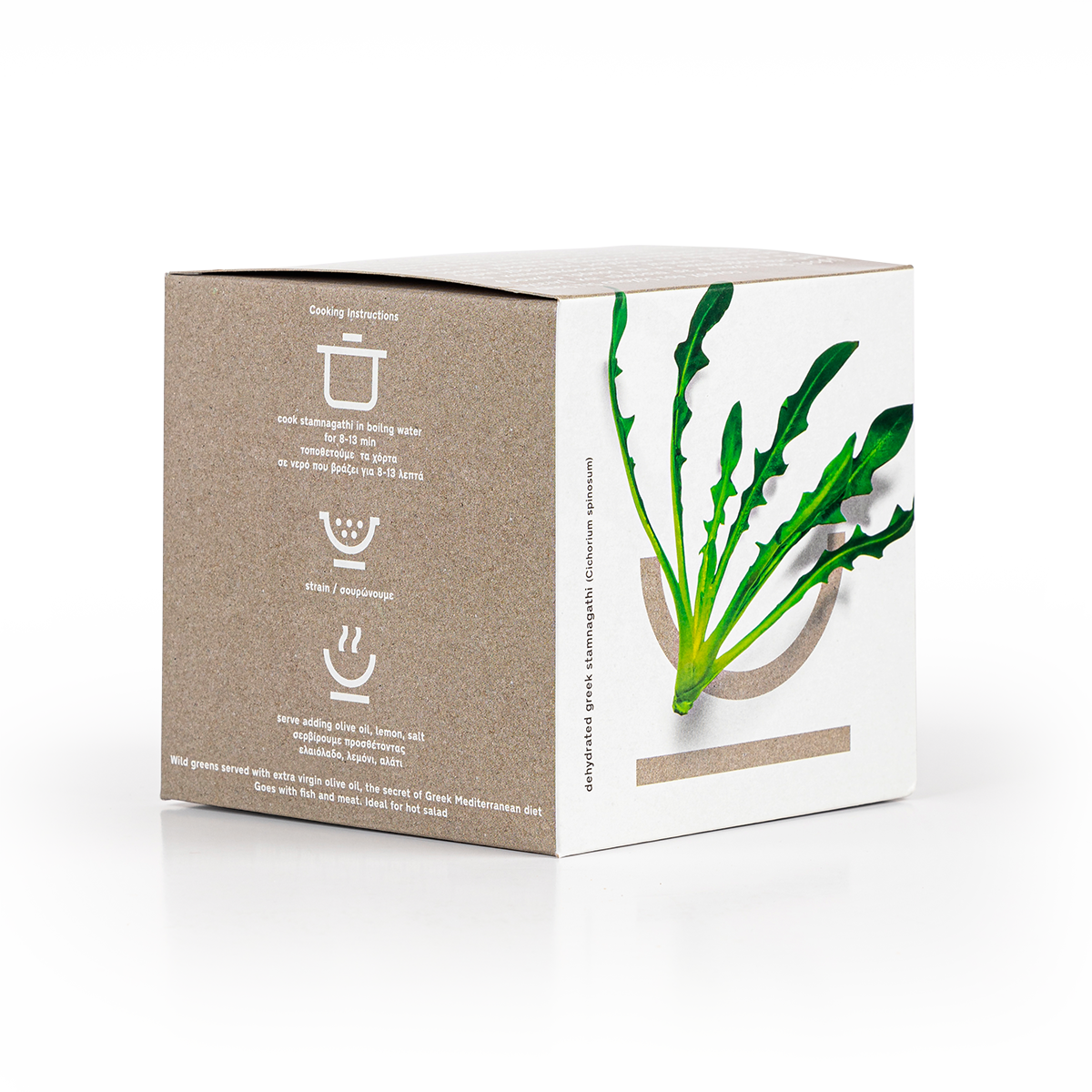READY IN 10 MINUTES
Dehydrated natural greens from the blessed land of Greece right in your kitchen.
READY IN 10 MINUTES
Dehydrated natural greens from the blessed land of Greece right in your kitchen.
Wild Horta
Combining our ancient local knowledge on food preservation with contemporary dehydration techniques we created a collection of Wild Horta species that we cultivate in the Greek land in the areas of their origin. Our dehydration method is based on the circulation of very low temperature air that has very low effect on the nutritional value of the greens. The greens are dehydrated naturally without the use any kind of chemicals or colors losing approximately 90% of the water they contain. This means that 15gr of dry greens equals approximately to 150gr of fresh ones.
Stamnagathi is the local name of Cichorium spinosum in Crete. In fact means the thorn of the pitcher as women used to close the pitchers with the sense thorns of the plant in order to protect the water or other kind of liquids were storing in them from insects and small animals.
In Nature Stamnagathi is found in the inaccessible parts of the mountains or on the rocks close to the sea and it grows to 20 cm in height. It is in flower from July to August and the flowers are hermaphrodite (have both male and female organs) and are pollinated by bees.
Stamnagathi has a bitter taste and can be eaten as a raw or boiled salad with extra virgin olive oil and lemon and added in various recipes combined with meat or fish.
Zohos is the local name of Sonchus Oleraceus. It’s one of the most common wild plants in Greece and you can find it almost everywhere. This annual plant has a hollow, upright stem up to 30–100 cm high. It prefers full sun, and can tolerate most soil conditions. The flowers are hermaphroditic, and common pollinators include bees and flies.
Zohos has a mild bitter flavor and can be eaten as a boiled salad with extra virgin olive oil and lemon or mixed with other greens. In very poor areas like Mani people were using Zohos also in pies combined with wild aromatic greens such.
Armiriki is the Greek name for Salsola soda. It is a halophyte (a salt-tolerant plant) that typically grows in coastal saline habitats and can be irrigated with salt water. Its stem rises with herbaceous stalks from 5 to 70 cm high.
Armiriki has salty and sweet flavor and it is usually eaten as a boiled salad with extra virgin olive oil and lemon. Fits perfectly with any kind of fish.
Cooking
Dry wild Horta are cleaned and washed and can be eaten directly without any other preparation.
Three simple steps are needed in order to enjoy a nutritious and tasty meal of Wild Horta.

1
- Boil Water 1 liter of water in a large casserole adding 1 teaspoon of salt

2
- Place the dry greens
in the casserole. - Boil 8 to 13 minutes.
- If you want greens more
crunchy 8 minutes are enough.

3
- Strain the greens.
- Serve with extra virgin olive oil and lemon.
Wild Horta
Combining our ancient local knowledge on food preservation with contemporary dehydration techniques we created a collection of Wild Horta species that we cultivate in the Greek land in the areas of their origin. Our dehydration method is based on the circulation of very low temperature air that has very low effect on the nutritional value of the greens. The greens are dehydrated naturally without the use any kind of chemicals or colors losing approximately 90% of the water they contain. This means that 15gr of dry greens equals approximately to 150gr of fresh ones.
Stamnagathi is the local name of Cichorium spinosum in Crete. In fact means the thorn of the pitcher as women used to close the pitchers with the sense thorns of the plant in order to protect the water or other kind of liquids were storing in them from insects and small animals.
In Nature Stamnagathi is found in the inaccessible parts of the mountains or on the rocks close to the sea and it grows to 20 cm in height. It is in flower from July to August and the flowers are hermaphrodite (have both male and female organs) and are pollinated by bees.
Stamnagathi has a bitter taste and can be eaten as a raw or boiled salad with extra virgin olive oil and lemon and added in various recipes combined with meat or fish.
zo.hos
[zohos]
Zohos is the local name of Sonchus Oleraceus. It’s one of the most common wild plants in Greece and you can find it almost everywhere. This annual plant has a hollow, upright stem up to 30–100 cm high. It prefers full sun, and can tolerate most soil conditions. The flowers are hermaphroditic, and common pollinators include bees and flies.
Zohos has a mild bitter flavor and can be eaten as a boiled salad with extra virgin olive oil and lemon or mixed with other greens. In very poor areas like Mani people were using Zohos also in pies combined with wild aromatic greens such.
ar.mi.ri.ki
[armiriki]
Armiriki is the Greek name for Salsola soda. It is a halophyte (a salt-tolerant plant) that typically grows in coastal saline habitats and can be irrigated with salt water. Its stem rises with herbaceous stalks from 5 to 70 cm high.
Armiriki has salty and sweet flavor and it is usually eaten as a boiled salad with extra virgin olive oil and lemon. Fits perfectly with any kind of fish.
Cooking
Dry wild Horta are cleaned and washed and can be eaten directly without any other preparation.
Three simple steps are needed in order to enjoy a nutritious and tasty meal of Wild Horta.

1
- Boil Water 1 liter of water in a large casserole adding 1 teaspoon of salt

2
- Place the dry greens
in the casserole. - Boil 8 to 13 minutes.
- If you want greens more
crunchy 8 minutes are enough.

3
- Strain the greens.
- Serve with extra virgin olive oil and lemon.







